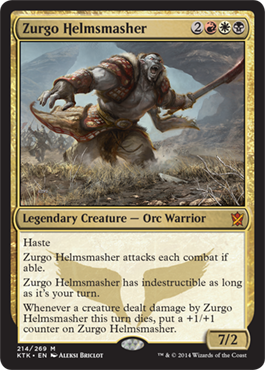Khan Do Attitude, Part 2
Welcome to the second Khans of Tarkir Preview Week. If you haven't read last week's article (aka Part 1), you might want to give it a look, as today's article assumes you've read it. I'm going to continue telling the story of Khans's design and before today's article is done, I'll have a preview card for you all to enjoy. That said, let's get on with the story.
Prose and Khans
Theros block had been top-down design based on Greek mythology and I was interested in pushing the pendulum to the other end of the spectrum. What could we start with for Khans of Tarkir block that was as granular and mechanical as I could get? I had an idea for a draft structure I was interested in trying (large/small/large, where the small set pivots and is drafted with each large set). Why not start there? I knew it would lead me down a very different path.
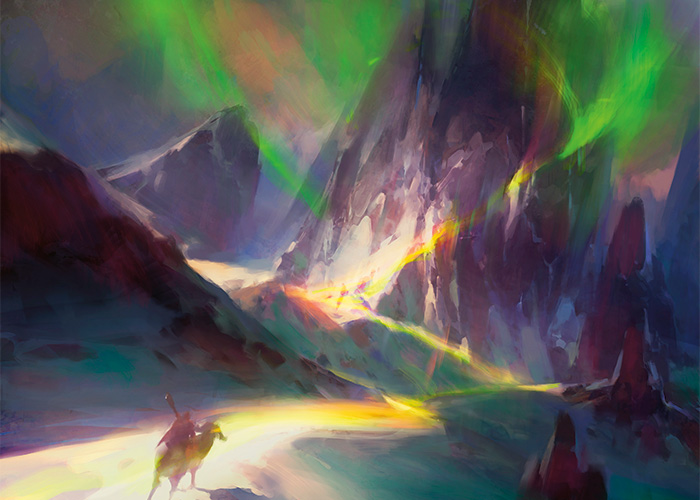
Art by Min Yum
As a quick aside, many players have asked me "Why start with a draft structure?" and the answer is that I feel it's important every year to start design from a different vantage point. I knew having to justify the draft structure would get us somewhere we'd never been before, and that really is the important thing needed from any design starting point. The fact that it was a draft structure wasn't the important part. It was just something that I knew would take us somewhere new and different.
The structure led to an archetypal story to explain it—a time-travel story—and that time-travel story led us to a block design. As the story isn't completely public yet, I can't fill you in on all the pieces, but suffice to say one of the big pieces we needed was a world in turmoil. We turned to the creative team and they gave us Tarkir, a battle-strewn plane run by a collection of vicious warlords, home to a Planeswalker named Sarkhan Vol.
Sarkhan's plane was once home to mighty dragons, but the clans, using Magic rooted in draconic origins (we'll get to this later in today's article), managed to kill off the dragons many years ago. All that remained was the clans, so that is where design went to next. The original four clans became five when creative realized there was one more faction they wanted to portray and, before you knew it, we had a wedge theme.
The design worked as such: each clan was centered in a color and had one ally color and one enemy color, resulting in a tri-color wedge combination. Each clan was also tied to an attribute of the dragon, which the clan tried to emulate. Here's the breakdown:
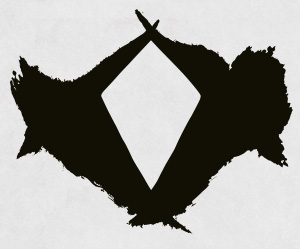
Abzan
WBG (centered in white)
Dragon Attribute: Endurance
Symbol: Scale of the Dragon
Khan: Anafenza
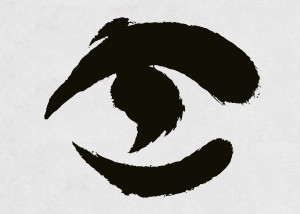
Jeskai
URW (centered in blue)
Dragon Attribute: Cunning
Symbol: Eye of the Dragon
Khan: Narset
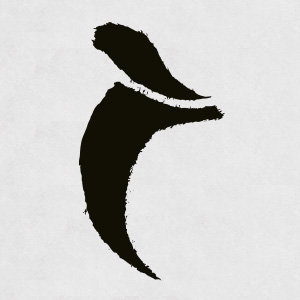
Sultai
BGU (centered in black)
Dragon Attribute: Ruthlessness
Symbol: Fang of the Dragon
Khan: Sidisi
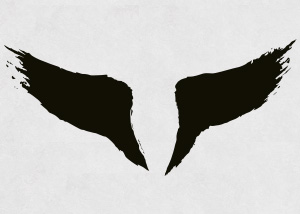
Mardu
RWB (centered in red)
Dragon Attribute: Speed
Symbol: Wing of the Dragon
Khan: Zurgo
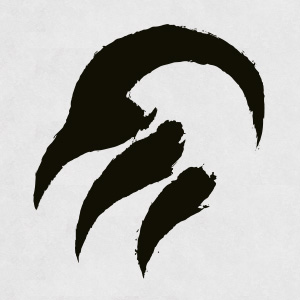
Temur
GUR (centered in green)
Dragon Attribute: Savagery
Symbol: Claw of the Dragon
Khan: Surrak
Once we established the five clans, the next job was giving each an identity and then finding a keyword mechanic for it. I should point out that we experimented with the idea of not having mechanics assigned one-for-one for each clan. The set already had morph (which I'll talk about in a little bit), so having a clan mechanic for each clan meant going to six mechanics, which is a bit on the high side. The problem was, no system we could come up with for how to distribute the mechanics was close to as clean as assigning them one per clan.
For example, we toyed with having four mechanics that showed up in multiple clans, but there was no clean, elegant solution. It had different mechanics treated differently and it was near impossible to get the mechanics to reinforce individual clan flavor. In the end, we decided that if we wanted to make clear factions, each with its own mechanical identity, we had to stick with the model of one mechanic per faction. This is a good example of where sometimes veering too far away from the low-hanging fruit causes problems.
It turns out that one of our five clan mechanics was discovered even before design started. The exploratory design team (led by Ethan Fleischer and Shawn Main) had been messing around with mechanics that played well with morph and stumbled upon raid. Raid is a simple mechanic where cards get rewarded when cast if at least one of your creatures has attacked that turn.
We liked how it played with morph, because it allowed players to attack with a morph creature without the opponent being sure what was going on. The existence of raid made players sometimes bluff attack (meaning it would be bad if the opponent blocked) to trigger the raid. This played nicely with morph, because the bluffing aspect is a big part of the mechanic and raid allowed another type of bluffing, which made blocking morph creatures more dynamic.
Once we had the five clans and started looking for mechanics, we realized that raid would be an excellent mechanic for the Mardu, as they were the aggressive clan that wanted to be constantly attacking. It took only one playtest to cement raid as the Mardu mechanic. Raid, by the way, was the design name of the mechanic.
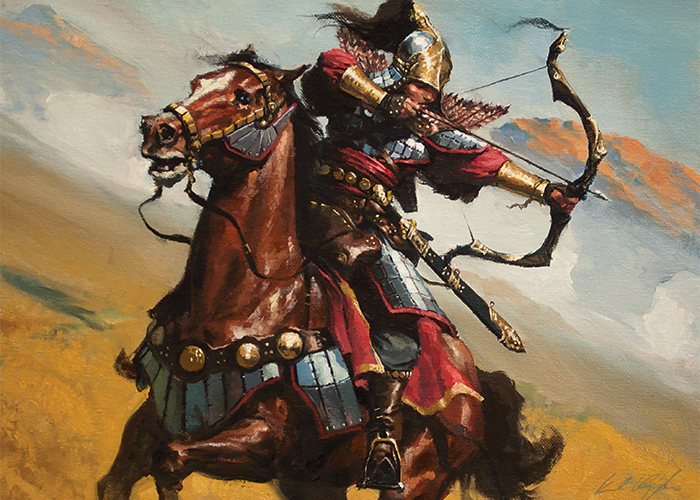
Art by Karl Kopinski
The next mechanic to get finalized as a clan mechanic was delve. Delve first appeared in Future Sight on three futureshifted cards.
Delve allows the caster to exile cards in his or her graveyard as a means to reduce the cost of the spell. The mechanic was popular and I was intent on finding it a home. We've considered the mechanic for multiple sets, and I even put it into Innistrad for a short time, but the mechanic never made it all the way to print. As we started thinking about the Sultai and learning more about the clan from the creative team, I realized we might finally have our match. I asked Adam Lee, the creative team representative, if delve made flavor sense. When Adam said it was a perfect fit, I put delve in the set later that day. The Sultai both like to manipulate resources and use death as a tool, so it fit right in.
The next mechanic to make it into the set was outlast for the Abzan clan. As the clan of endurance, I knew Abzan was going to be the slow, controlling clan. The original version of outlast allowed a creature to forego an attack in exchange for getting a +1/+1 counter. It required tapping them at the time attackers were chosen. Development would later tweak it to simplify it into its current version. Development was also who added most of the granting of abilities to your creatures with +1/+1 counters. This was done to allow the clan to build more around the mechanic. Previously, there wasn't enough of an impetus to want to play multiple outlast creatures.
Unlike raid and delve, for a while we weren't sure that outlast was the right mechanic for its clan. The flavor was great but we weren't positive if it was the gameplay we wanted. We tried various things but found ourselves constantly coming back to outlast. In design, by the way, the mechanic was called hunker down. So, during your attack, you would say, "He attacks, she attacks, and this one hunkers down." While outlast is a good name, I will miss getting to hunker down.
The fourth mechanic to find its way into the file was prowess, originally called kung fu in design. The original version I proposed granted the creature +1/+1 whenever any card was cast. That proved to be a little too powerful, so for a while we tried getting +1/+1 whenever a creature was cast, but that too was a little stronger than we wanted. We then tried triggering off of a noncreature spell being played. That seemed to hit the spot we were aiming for.
Then, one day, Jon Loucks was playtesting the set and said he was happy we were using his mechanic, energize. I went back and looked it up. Energize was a mechanic Jon had pitched during the second design challenge. Here's an example:
CW02—Lightglider (common)
Creature—Human Soldier
1/1
Energize—Whenever you cast a noncreature spell, Lightglider gets +2/+2 and gains flying until end of turn.
Interestingly, when I judged energize, I said I liked it but that Jon was giving too big an effect when the noncreature spell was cast. So, basically, after a bunch of playtesting, we ended up with a mechanic Jon had suggested years earlier. Obviously, it had been stuck in my head waiting for a good place to be used. Well, it turns out that the Jeskai clan was the place. Congrats Jon.
I should note that one of the reasons the mechanic fit Jeskai so well is that it creates an interesting tension. Most of the time, your opponent doesn't know whether or not you can play a noncreature spell, and with instants, your creature has the ability to grow at just about any time.
The final mechanic was the one for the Temur clan. We actually tried a bunch of different mechanics and it took a while to find something we liked. The Temur was the clan with the beefiest creatures that were supposed to be the superior fighters. Was there some way to reward creature size?
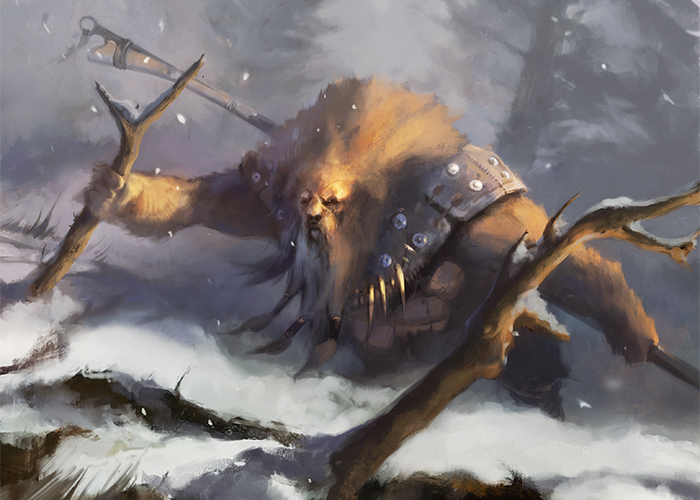
Art by Evan Shipard
The answer turned out to be a cross between the unnamed Naya mechanic from Shards of Alara and morbid. Naya cared about creatures with a power of 5 or greater. What if we used creature size on a threshold mechanic? That is, on a series of spells that got stronger if you had a big enough creature on the battlefield, similar to how morbid improved if a creature had died that turn. We experimented with different sizes but ended up at caring about a power of 3. That's right. We ended up at 3. Development would later change the number to 4, as 3 proved a little too easy a threshold to hit.
It did come up that both raid and ferocious (called power-up in design) were threshold mechanics, but we felt that attacking and having a large creature led to different enough styles of gameplay that the two coexisting was fine.
This is one of those designs where the decisions behind the choice of the mechanics was larger than just the first set. Once you know the entire block, you'll see that there's much more at play with the mechanics than simply which clan they belong in, but as it requires you knowing things you don't know yet, you're going to have to wait for some design articles later in the block to give some more perspective to what we were up to with the design of the Khans of Tarkir mechanics.
Suffice to say, we wanted to make sure each clan had a mechanic and a play pattern where the act of playing with that clan reinforced the feel of the clan. Abzan is trying to endure. Jeskai is trying to outsmart. Sultai is trying to manipulate. Mardu is trying to race. And Temur is trying to outmuscle the opponent through bigger, beefier creatures.
But Wait, There's Morph
Today's article is a difficult one, because I'm trying to explain how the design came together but I don't want to ruin the surprises in store for you all, so please bear with me. The addition of morph actually predates the clans. It was in the set before we even knew for sure that the clans were going to exist. What? You see, while the draft structure might have been the jumping-off point for the design, the actual structure was based on the time-travel story. Yes, the one I can't completely tell you about.
Here's what happened. The time-travel story we got was an archetypal one ,which meant the goal of the design was to reinforce that story. That particular archetype was chosen because it would allow each of the three sets to have a very clear identity and enable us to build the block plan around them.
Before we continue, I want to talk for a second about time-travel stories. Basically, time-travel stories fall into three camps—they are about observing things, changing things, or both. Time-travel stories about observation are about characters visiting other times to learn things they did not know. Usually, the growth in those stories happen in the characters doing the observation. Time-travel stories about change involve characters visiting other times and doing things that forever alter the timeline. Most time-travel stories, though, are about both. Marty McFly, for example, goes back to the time of his parents' youth to both learn about who his parents are by seeing them from a different vantage point and to take actions that result in completely changing the status quo of his present day.
The time-travel story we wanted to tell was both. There was going to be observation but there was also going to be change. As Magic thrives when it's telling environmental stories, change is something we tend to embrace. For the design, that meant the block plan was going to be about change. Once again, I can't yet explain exactly how things are going to change, but be prepared that things will change. This is why, at the San Diego Comic-Con panel—where we first started talking about Khans of Tarkir—I stressed that Khans of Tarkir, the set, was about wedge, but Khans of Tarkir, the block, was not.
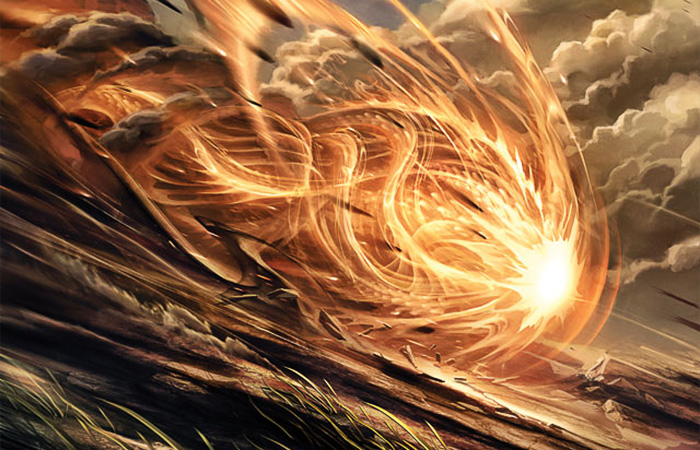
Art by Raymond Swanland
The exploratory team first stumbled upon morph because we needed a mechanic that could go through a series of changes. Morph in Khans of Tarkir wanted to be morph pretty much as you know it. There are a few tweaks and couple of new things, but we wanted to start out the block with the morph players already knew and loved. Let me stress, though, that as with the wedge theme, morph is going to go through some changes in this block, and not necessarily in the way many of you might expect. Most of that talk, though, is going to have to wait for Fate Reforged and "Louie."
What I can talk about, though, is how we designed morph to be used in Khans of Tarkir. We knew that each clan was going to have its own mechanic, so it felt correct that every clan would have access to morph. In the story, morph is descended from a draconic magic. The humans (and humanoid creatures) of Tarkir managed to take the draconic magic and warp it to their own means. The key to the magic is that it hides the identity of the creature using it, making it harder to fight against, as you are forced to fight blindly without any knowledge of your foe.
The key for the design team was to figure out how each clan would use morph differently.
Abzan—The endurance clan is playing the long game, so it wanted its morph creatures to be bigger. If Abzan manages to stretch out the game, the morph creatures that remain can be turned into giant creatures, usually with toughness greater than power, to help win the endgame.
Jeskai—The cunning clan wants to constantly keep the opponent guessing, which plays perfectly into morph's strengths. The Jeskai's morph cards are more likely to surprise opponents, causing them to play suboptimally, because they weren't aware of what Jeskai was up to.
Sultai—The ruthlessness clan enjoys manipulating the opponent, so it uses the morph creatures as a means to get dangerous things out without the opponent realizing the threats sitting before him or her.
Mardu—The speed clan wants to use its morph creatures to play into its aggressive nature. As such, Mardu tends to have the morph creatures with the lowest morph costs.
Temur—The savagery clan uses morph to ramp into its larger creatures quicker. Like Abzan, it tends to have bigger creatures, but Temur's tend to be more aggressive and less defensive in nature.
We also spent some time exploring some new design space for morph we could play around with. I can't tell you all of the stuff we came up with, but I can show off one new morph card, today's preview card.
World, I would like you to meet Ashcloud Phoenix. Click here to get acquainted.
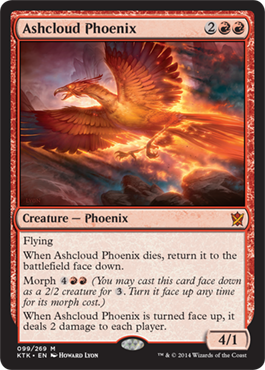
Ashcloud Phoenix came about because we were playing around with different ways to interact with morph. One idea was to have a morph creature that dies back into its morph state, allowing it to be continually reborn. The creative team turned that idea into a Phoenix.
Two Final Things
Before I sign off for the day, I wanted to answer the two most pressing questions I've been getting about the set and block.
How are we able to go back to multicolor so soon. Return to Ravnica block was just two years ago?
The answer is that Khans of Tarkir block does have a multicolor component, and a high-profile one, but is in many ways much less of a multicolor block. The best way to explain this is by using what we in R&D call as-fan. As-fan is a term describing how many cards of a subset in question you can be expected to open, on average, when you open a booster pack of a particular set. As-fan is important because it talks about actual percentages that a player will get.
For this explanation, I'm going to talk about the as-fan of multicolor cards. In Return to Ravnica, the as-fan of multicolor cards was 3.58. That is, if you opened a random Return to Ravnica booster, you would expect an average of 3.58 multicolor cards. In contrast, if you open a Khans of Tarkir booster, you will get as as-fan of 1.85. What this means is that Return to Ravnica had almost twice the as-fan of multicolor cards of Khans of Tarkir. In plain English speak, that means that Khans of Tarkir will have multicolor cards but not nearly in the volume (very close to half) that they appeared in Return to Ravnica.
Why are the mana symbols on the wedge cards in Khans of Tarkir different than previous wedge cards?
One of the things development is very concerned with is making sure that the average player understands the basic strategy of the set he or she is playing with. While drafting Khans of Tarkir with Magic players in the building who weren't from R&D, Erik Lauer, the set's lead developer as well as R&D's head developer, realized they were missing a very important basic drafting strategy. In Khans of Tarkir, if you start by drafting two color, there is a big different between drafting an ally-colored pair and an enemy-colored pair.
Ally-color pairs only allow you a single wedge option, while enemy-color pairs leave you open to draft two different clans. For instance, if you start by drafting white-blue, you can only then go on to draft the Jeskai wedge, but if you start by drafting blue-red, you leave yourself open to both Jeskai and Temur. Many of the players were missing this, so Erik tried an experiment. By shifting the mana costs such that the enemy pairs were sitting next to each other in mana costs, it became a little easier to recognize that each wedge was made up of two enemy-color combinations.
Erik's playtesting showed that it helped enough that he talked about it with Del Laugel, Magic's lead editor, and she agreed to the change.
"Khaaan!!"
I hope you enjoyed this two-week romp through the design of Khans of Tarkir. As the block evolves, I'll have the chance to fill in some of the blanks I unfortunately had to leave today. As always, I am eager for your feedback. You can email me or contact me through any of my social media (Twitter, Tumblr, Google+, Instagram).
Join me next week when I get to talk more about Khans of Tarkir's design, as I start telling card-by-card design stories.
Until then, may you shout, "Yes, I Khan!"
"Drive to Work #154—Design 101"
Today's first podcast is based on an article I wrote many years ago talking about the most common mistakes of new game designers. If you are at all interested in game design, you might want to give this a listen.
"Drive to Work #155—Keeping Secrets"
The second podcast answers the question "What is the worst thing about your job?" The answer: having to keep secrets about all the cool things we're up to.
- Episode 155 : Keeping Secrets
- Episode 154 : Design 101
- Episode 153 : Who's Who—R&D, The Second Wave (13.3 MB)
- Episode 152 : Unhinged, Part 5 (17.9 MB)
- Episode 151 : Unhinged, Part 4 (16.1 MB)
- Complete Drive To Work Podcast Archive
So You Want to Work at Wizards?
Long ago, I was talking to someone at Wizards who was complaining about having trouble finding an employee for a job that required a certain amount of Magic knowledge. I said, "Well, I happen to know where you can find tens of thousands of Magic players, many of whom would love a chance to work at Wizards." That resulted in the very first job posting at the end of my column. Well, it's worked out well both for Wizards and for my readers, so the tradition continues.
Here's today's job at Wizards that might just be perfect…for you: director, global communications.
The requirements are:
- A minimum of 7 years communications and/or marketing and/or publicity experience required
- Management of a communications/public relations budget
- Management of third party communications/public relations resources
- Bachelor's degree required or commensurate industry experience. Degree in marketing, communications or publicity preferred
And asks for the following knowledge, skills, and abilities:
- Exceptional oral and written communications skills
- Ability to apply communications knowledge and experience in a complex, fast-paced global environment
- Demonstrated ability to develop and lead execution of effective communication programs for entertainment and/or gaming brands
- Demonstrated ability to deliver promotional programs enhancing the profile of entertainment and/or gaming brands
- Ability to collaborate effectively with colleagues, agencies and partners across the organization
- Effective people management skills
- Strong organization and time management skills
- Flexibility and positive attitude
If you think that sounds like you, see the full job listing here.
There are also a number of other Magic-related jobs posted online, so take a look and see if any of the other openings sound like they'd fit you.


